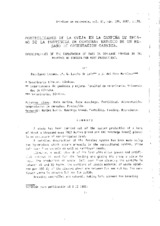Mostrar el registro sencillo del ítem
Posibilidades de la oveja en la campiña de secano de la provincia de Córdoba: estudio de un rebaño de orientación cárnica
| dc.contributor.author | Rodríguez Lozano, J. | es_ES |
| dc.contributor.author | Pino Martínez, José del | es_ES |
| dc.contributor.author | Lancho de León, G. | es_ES |
| dc.date.accessioned | 2010-05-03T07:54:01Z | |
| dc.date.available | 2010-05-03T07:54:01Z | |
| dc.date.issued | 1982 | |
| dc.identifier.issn | 1885-4494 | |
| dc.identifier.uri | http://hdl.handle.net/10396/3128 | |
| dc.description.abstract | A study has been carried out of the system production of a herd of about a thousand ewes (920 Merino breed and 180 Manchego breed) placed in an enclosure of non-irrigated land. A detailed description of the feeding system has been made using the by-product which occurs annually in the agricultural system, straw left over from cereals as well as sunflower seeds. Likewise, a small stretch of the land with olive groves and artificial meadows is used for the needing and giving the sheep a place to rest. The production of waste left over from cleaning the weat/Ha is between 44 and 90 Kg/Ha. The portions of usable material of waste obtained per 100 Kg of the cleaned wheat are between 2.4 and 4.8 Kg. The sunflower waste is between 6.1 and 7.4 p.100. Breeding controlled and natural, taking into account the breeding response of the herd to the different seasons and the different forms of feeding. The resulting fertility (number of sheep that has given birth /n°- sheep mated) in the Manchego breed is of 88,85 and 52 p.100 mated in autumm, summer and spring, respectively, being in Merino breed of 86,87 and 74 p.100, respectively | en |
| dc.description.abstract | Se realiza un estudio del sistema productivo de una explotación de unas mil ovejas (920 merinas y 180 manchegas), situadas en una finca de secano, convenientemente cercada, del término de Palma del Río (Córdoba). Se efectúa una descripción detallada del sistema de alimentación, a base de la utilización de los subproductos existentes anualmente en la explotación agricola; concretamente, paja de cereales, impurezas resultantes de la limpieza de los granos de trigo y otros cereales, así como de semillas de girasol. Igualmente., se utiliza una pequeña parte de la finca ocupada por olivar y sembrado de pradera artificial para alimentación y zona de descanso del ganado. La producción de impurezas resultantes de la limpia de trigo/Ha oscila entre 44 y 90 Kg/Ha. Los rendimientos de las impurezas conseguidas por 100 Kg de trigo limpio están entre 2.4 y 4.8 Kg. Las impurezas de girasol, entre 6.1 y 7.4 p.100. La reproducción es dirigida y natural. Se estudia la respuesta reproductiva del rebaño a las diferentes estaciones y formas de alimentación. La fertilidad resultante (n°- ovejas paridas/n°- ovejas en cubrición) en las ovejas de raza manchega, es de 88, 85 y 52 p.100 cubriciones en otoño, verano y primavera, respectivamente. En las merinas, de 86, 87 y 74 p.100, respectivamente. | es_ES |
| dc.format.mimetype | application/pdf | es_ES |
| dc.language.iso | spa | es_ES |
| dc.publisher | Universidad de Córdoba, Servicio de Publicaciones | es_ES |
| dc.rights | https://creativecommons.org/licenses/by-nc-nd/4.0/ | es_ES |
| dc.source | Archivos de zootecnia 31 (120), 171-181 (1982) | es_ES |
| dc.subject | Producción animal | es_ES |
| dc.subject | Subproductos de cereales | es_ES |
| dc.subject | Alimentación | es_ES |
| dc.subject | Fertilidad | es_ES |
| dc.subject | Raza merina | es_ES |
| dc.subject | Raza manchega | es_ES |
| dc.title | Posibilidades de la oveja en la campiña de secano de la provincia de Córdoba: estudio de un rebaño de orientación cárnica | es_ES |
| dc.title.alternative | Possibilities of the explotation of ewes in dry-lang: farhing in the province of Córdoba for meat production | en |
| dc.type | info:eu-repo/semantics/article | es_ES |
| dc.relation.publisherversion | http://www.uco.es/organiza/servicios/publica/az/az.htm | es_ES |
| dc.rights.accessRights | info:eu-repo/semantics/openAccess | es_ES |

